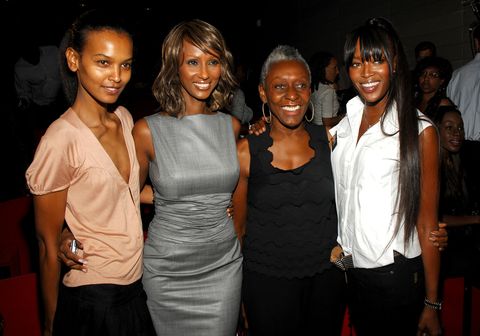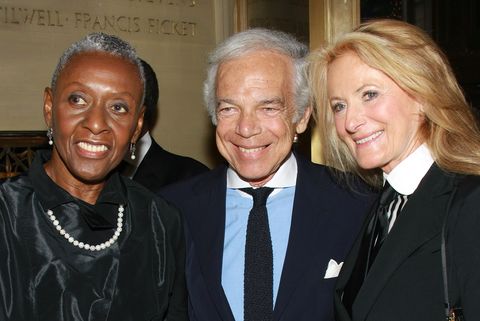The fashion industry has changed significantly since model-turned-advocate Bethann Hardison got her start in a Garment District button factory. As part of ELLE’s look at the future of fashion, she shares her views on the industry’s current struggles and how she personally has effected change over the decades.
When did you decide to leave modeling and go into activism?
First of all, I’m not an activist. People say that, but I’m an advocate and it’s a little different. I’ve had moments of activism for sure, but as I like to say, “an activist has to remain active.” When I left modeling, it was just because I felt I had done it and the time was up. I was tired of entertaining the crowd, so it was just like “Next!” I walked down the runway and saw Polly Mellen sitting front row, screaming my name, and at that moment I knew I didn’t want to do this anymore. Simple.
I grew up in the garment business, so I always had a full-time job. I was a runway model, but I had other things that I did. I’d just opened up a showroom that represented Valentino and other Italian brands from this factory out of Como. I had been working with Valentino at that time in Rome and so they were the ones that told the factory, “OK, you work with her in New York and we’ll give you the licensing on our swimwear.” I never wanted to have a modeling agency, but people convinced me that that’s what I needed to do. I was originally going to partner with a French woman, but she switched up on me at the last minute, so I knew I had to do it on my own, but I didn’t have a pot to piss in. But it all worked out.
How?
One of my top models at the time whom I’d represented at Click and always believed in me, a white girl, she just made sure she found the money and all the models said “No no no, we don’t need to get paid first. We’ll take the hit.” And that did very well from about ’84—’96, when I just decided I couldn’t do it anymore. It was hard to do because it was successful, and we were doing good things that were making a difference. It was a white agency with Black kids and Asian kids and Latino kids. It wasn’t a Black model agency, but it had a Black owner.
Are the conversations you were having then with the industry regarding representation any different than the ones you’re having now, either from the model or designer perspective?
Every industry has its exclusions. Fashion, television, you name it. It’s all about referrals: What have you done and who have you done it for? Everyone fears risking something new, like a retailer taking a chance on a relatively unknown designer. That’s like in the Roman times, that’s not unusual. There are stores willing to take risks but I just wish people had more history. A lot of people don’t know because they’re brand new with this.
Back in the day, when I was coming up in the ’70s, we didn’t have this frustration that seems to be percolating in the industry. Number one, the Garment District is a whole different thing than the fashion business. The fashion business is a glamorous entity that people seem to have gotten their knickers all in a twist about. It was organic: people came along, designers came along, everything just started to brew. We didn’t feel the feeling like we are now. People started coming out and just became entities. It became a community of people who designed, white, Black, and so on. We just kind of showed up and it you had style and creativity, you got noticed. It’s unfortunate that our industry has gotten full-on with so many inhabitants. Before it was a tiny little elitist island that nobody gave any care about, nor did the island itself invite many people because it was very exclusive in the sense that designers didn’t even have outside people come to their fashion shows. There was a fear of lines being copied and everything was very private. Nobody cared about being part of the industry or going to fashion shows and then one day that changed. And once that changed, everything started to change.
What caused that?
I don’t know but all of a sudden, the designers started inviting celebrities into the shows. Believe me, I’m telling you, it was never like that before. A few people here, a few people there and the outside world started being invited in. Next thing you know, popular culture has begun to run the show. All of a sudden, we had things called bloggers, I didn’t even know how to spell it. All of a sudden they’re in front of you. Important retailers and editors can’t even see the shoe of the girl walking down the runway.
So now with all these people wanting to be on inside, they start to dictate a little bit. When you say that I’ve been fighting for diversity and inclusion in our industry for so long, this is not true. A lot of people think that but what I have done—and I do believe I am a revolutionary because of how I have functioned—I think you basically have a calling and at some point in time you just call things out along the way, but you don’t start doing that until it’s time.
What was that time for you?
My modeling agency started in 1984 down in TriBeCa on North Moore Street and because of who I was and all the designers that knew me and what I stood for, they were all really happy to support my agency. But I had a good agency, good talent, and a good eye. At that point, all the big designers such as Calvin Klein only used runway girls because that’s who serviced that segment of the industry. But Calvin, being the great marketer he is, decided he wanted to put the print girl on the runway so that the editors could already visualize the editorial. So the girls that went to [the Battle of] Versailles, like myself, and Billie and Pat, those girls started to be replaced by print girls. They’d never walked, never done a fashion show before but they were the image that he wanted to see. As different as designers can be in their work, they all pretty much follow the yellow brick road. So that became the trend.
And so there weren’t many Black print girls. Black runway models, yes, but not print girls so that’s when the image began to change of what you see on the runway. And it wasn’t just Calvin, it was Perry Ellis, Donna Karan, all of them. And so I started getting calls from them: “We need you to find us a Black girl, Bethann, we need a great Black girl.” And then I would say things like, OK, how many girls are you using? And they’d say 35. And I’d say, OK, you want one Black girl? I was very good at turning the tables on them, to let them see how awful that sounds. I always knew the playing field. So when, say, Brides would call to book Catherine, one of my top girls and a white brunette, I’d say, “Let me ask you something. You do realize that Black people get married, too?” And they were often taken aback, because race wasn’t something easily discussed, but you have to educate people.
Several people I’ve interviewed have said they simply want to be recognized for being a great designer, not a great Black designer. What is your view?
Look, I don’t want the President of the United States to be called the Black President. We were always distinguished as Black but we didn’t have to wear it. There was a feature in the New York Times where the fashion editor called us “those Black stallions” and we took pride in that. And then Newsweek did a story on how successful so many Black models had become, but when it came down to the Black designers, if there was a group of them covered they would go back to them and say they couldn’t say it was a group of Black designers. Designers didn’t design thinking they were Black designers, they just designed because everyone was equal back in the day. Giorgio di Sant’Angelo, Halston, everybody was sort of in the same culture. But it didn’t mean that the press wouldn’t call our color out, they could and we never took offense to it but nobody wanted to be known and be thought of as a “Black designer”—what does that mean? People would be conscious of how they used it and when they used it.
This interview has been edited and condensed for clarity.
Read More On The Future Of Fashion
This content is created and maintained by a third party, and imported onto this page to help users provide their email addresses. You may be able to find more information about this and similar content at piano.io



